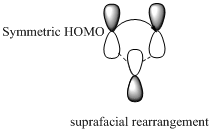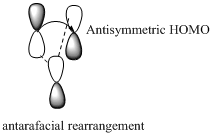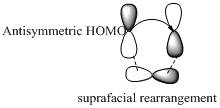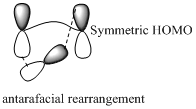
Interpretation:
The correct product should be identified for the given [1, 3] sigmatropic rearrangement reaction.
Concept introduction:
In a sigmatropic reaction “ one new sigma-bond is formed as another breaks.”

Sigmatropic rearrangement reactions are designated with digits. For example a [1, 3] sigmatropic rearrangement describe a reaction in which the residue migrates from position 1 to position 3.
[3,3] sigmatropic rearrangement of a 1,3-diene known as Cope rearrangement reaction.
Woodward –Hoffmann rules are the set of rules used to vindicate or predict certain aspects of the stereo chemical outcome and activation energy of pericyclic reactions.
Woodward – Hoffmann rules for sigmatropic rearrangement reactions are listed below


Carbon migrating with one lobe of its p orbital interacting


Carbon migrating with both lobe of its p orbital interacting


of configuration is the inversion of a chiral center in a molecule in a
Want to see the full answer?
Check out a sample textbook solution
Chapter 28 Solutions
Organic Chemistry, Books a la Carte Edition (8th Edition)
- U Consider the following graph containing line plots for the moles of Product 1 versus time (minutes) and the moles of Product 2 versus time in minutes. Choose all of the key terms/phrases that describe the plots on this graph. Check all that apply. ▸ View Available Hint(s) Slope is zero. More of Product 1 is obtained in 12 minutes. Slope has units of moles per minute. plot of minutes versus moles positive relationship between moles and minutes negative relationship between moles and minutes Slope has units of minutes per moles. More of Product 2 is obtained in 12 minutes. can be described using equation y = mx + b plot of moles versus minutes y-intercept is at (12,10). y-intercept is at the origin. Product Amount (moles) Product 1 B (12,10) Product 2 E 1 Time (minutes) A (12,5)arrow_forwardSolve for x, where M is molar and s is seconds. x = (9.0 × 10³ M−². s¯¹) (0.26 M)³ Enter the answer. Include units. Use the exponent key above the answer box to indicate any exponent on your units. ▸ View Available Hint(s) ΜΑ 0 ? Units Valuearrow_forwardLearning Goal: This question reviews the format for writing an element's written symbol. Recall that written symbols have a particular format. Written symbols use a form like this: 35 Cl 17 In this form the mass number, 35, is a stacked superscript. The atomic number, 17, is a stacked subscript. "CI" is the chemical symbol for the element chlorine. A general way to show this form is: It is also correct to write symbols by leaving off the atomic number, as in the following form: atomic number mass number Symbol 35 Cl or mass number Symbol This is because if you write the element symbol, such as Cl, you know the atomic number is 17 from that symbol. Remember that the atomic number, or number of protons in the nucleus, is what defines the element. Thus, if 17 protons are in the nucleus, the element can only be chlorine. Sometimes you will only see 35 C1, where the atomic number is not written. Watch this video to review the format for written symbols. In the following table each column…arrow_forward
- need help please and thanks dont understand only need help with C-F Learning Goal: As discussed during the lecture, the enzyme HIV-1 reverse transcriptae (HIV-RT) plays a significant role for the HIV virus and is an important drug target. Assume a concentration [E] of 2.00 µM (i.e. 2.00 x 10-6 mol/l) for HIV-RT. Two potential drug molecules, D1 and D2, were identified, which form stable complexes with the HIV-RT. The dissociation constant of the complex ED1 formed by HIV-RT and the drug D1 is 1.00 nM (i.e. 1.00 x 10-9). The dissociation constant of the complex ED2 formed by HIV-RT and the drug D2 is 100 nM (i.e. 1.00 x 10-7). Part A - Difference in binding free eenergies Compute the difference in binding free energy (at a physiological temperature T=310 K) for the complexes. Provide the difference as a positive numerical expression with three significant figures in kJ/mol. The margin of error is 2%. Part B - Compare difference in free energy to the thermal…arrow_forwardneed help please and thanks dont understand only need help with C-F Learning Goal: As discussed during the lecture, the enzyme HIV-1 reverse transcriptae (HIV-RT) plays a significant role for the HIV virus and is an important drug target. Assume a concentration [E] of 2.00 µM (i.e. 2.00 x 10-6 mol/l) for HIV-RT. Two potential drug molecules, D1 and D2, were identified, which form stable complexes with the HIV-RT. The dissociation constant of the complex ED1 formed by HIV-RT and the drug D1 is 1.00 nM (i.e. 1.00 x 10-9). The dissociation constant of the complex ED2 formed by HIV-RT and the drug D2 is 100 nM (i.e. 1.00 x 10-7). Part A - Difference in binding free eenergies Compute the difference in binding free energy (at a physiological temperature T=310 K) for the complexes. Provide the difference as a positive numerical expression with three significant figures in kJ/mol. The margin of error is 2%. Part B - Compare difference in free energy to the thermal…arrow_forwardPlease correct answer and don't used hand raitingarrow_forward
- need help please and thanks dont understand a-b Learning Goal: As discussed during the lecture, the enzyme HIV-1 reverse transcriptae (HIV-RT) plays a significant role for the HIV virus and is an important drug target. Assume a concentration [E] of 2.00 µM (i.e. 2.00 x 10-6 mol/l) for HIV-RT. Two potential drug molecules, D1 and D2, were identified, which form stable complexes with the HIV-RT. The dissociation constant of the complex ED1 formed by HIV-RT and the drug D1 is 1.00 nM (i.e. 1.00 x 10-9). The dissociation constant of the complex ED2 formed by HIV-RT and the drug D2 is 100 nM (i.e. 1.00 x 10-7). Part A - Difference in binding free eenergies Compute the difference in binding free energy (at a physiological temperature T=310 K) for the complexes. Provide the difference as a positive numerical expression with three significant figures in kJ/mol. The margin of error is 2%. Part B - Compare difference in free energy to the thermal energy Divide the…arrow_forwardPlease correct answer and don't used hand raitingarrow_forwardPlease correct answer and don't used hand raitingarrow_forward
- Can you tell me if my answers are correctarrow_forwardBunsenite (NiO) crystallizes like common salt (NaCl), with a lattice parameter a = 4.177 Å. A sample of this mineral that has Schottky defects that are not supposed to decrease the volume of the material has a density of 6.67 g/cm3. What percentage of NiO molecules is missing? (Data: atomic weight of Ni: 58.7; atomic weight of O: 16).arrow_forwardA sample of aluminum (face-centered cubic - FCC) has a density of 2.695 mg/m3 and a lattice parameter of 4.04958 Å. Calculate the fraction of vacancies in the structure. (Atomic weight of aluminum: 26.981).arrow_forward
 Organic Chemistry: A Guided InquiryChemistryISBN:9780618974122Author:Andrei StraumanisPublisher:Cengage Learning
Organic Chemistry: A Guided InquiryChemistryISBN:9780618974122Author:Andrei StraumanisPublisher:Cengage Learning
